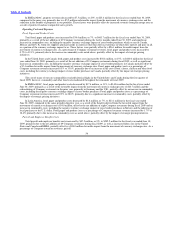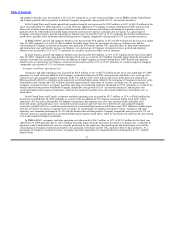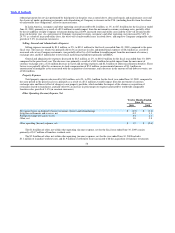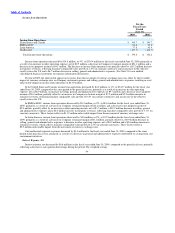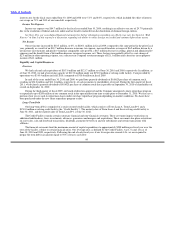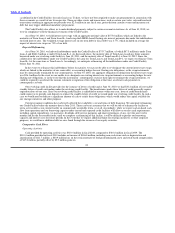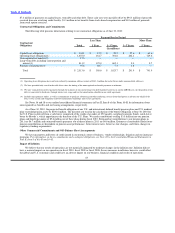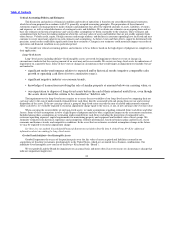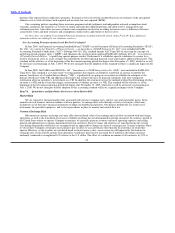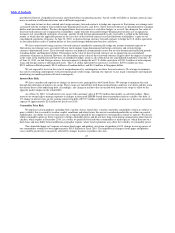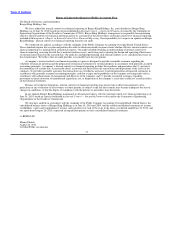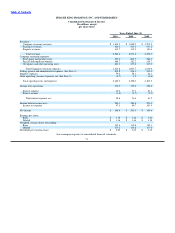Burger King 2010 Annual Report Download - page 67
Download and view the complete annual report
Please find page 67 of the 2010 Burger King annual report below. You can navigate through the pages in the report by either clicking on the pages listed below, or by using the keyword search tool below to find specific information within the annual report.
Table of Contents
Our impairment test for goodwill requires us to compare the carrying value of reporting units with assigned goodwill to fair value.
Our reporting units with assigned goodwill are the U.S. & Canada and APAC. If the carrying value of a reporting unit exceeds its fair
value, we may be required to record an impairment charge to goodwill. Our impairment test for the Brand consists of a comparison of
the carrying value of the Brand to its fair value on a consolidated basis, with impairment equal to the amount by which the carrying
value of the Brand exceeds its fair value. We determined the fair value of our U.S. & Canada reporting unit and the fair value of our
Brand were substantially in excess of their respective carrying values when we performed our annual goodwill and Brand impairment
tests as of April 1, 2010.
When testing goodwill and the Brand for impairment, we make assumptions regarding the amount and the timing of estimated
future cash flows similar to those when testing long−lived assets for impairment, as described above. In the event that our estimates or
related assumptions change in the future, we may be required to record an impairment charge.
See Note 2 to our audited Consolidated Financial Statements included in Part II, Item 8 of this Form 10−K for additional
information about accounting for long−lived assets.
Accounting for Income Taxes
We record income tax liabilities utilizing known obligations and estimates of potential obligations. A deferred tax asset or liability
is recognized whenever there are future tax effects from existing temporary differences and operating loss and tax credit
carry−forwards. When considered necessary, we record a valuation allowance to reduce deferred tax assets to the balance that is more
likely than not to be realized. We must make estimates and judgments on future taxable income, considering feasible tax planning
strategies and taking into account existing facts and circumstances, to determine the proper valuation allowance. When we determine
that deferred tax assets could be realized in greater or lesser amounts than recorded, the asset balance and income statement reflect the
change in the period such determination is made. Due to changes in facts and circumstances and the estimates and judgments that are
involved in determining the proper valuation allowance, differences between actual future events and prior estimates and judgments
could result in adjustments to this valuation allowance.
We file income tax returns, including returns for our subsidiaries, with federal, state, local and foreign jurisdictions. We are
subject to routine examination by taxing authorities in these jurisdictions. We apply a two−step approach to recognizing and measuring
uncertain tax positions. The first step is to evaluate available evidence to determine if it appears more likely than not that an uncertain
tax position will be sustained on an audit by a taxing authority, based solely on the technical merits of the tax position. The second step
is to measure the tax benefit as the largest amount that is more than 50% likely of being realized upon settling the uncertain tax position.
Although we believe we have adequately accounted for our uncertain tax positions, from time to time, audits result in proposed
assessments where the ultimate resolution may result in us owing additional taxes. We adjust our uncertain tax positions in light of
changing facts and circumstances, such as the completion of a tax audit, expiration of a statute of limitations, the refinement of an
estimate, and interest accruals associated with uncertain tax positions until they are resolved. We believe that our tax positions comply
with applicable tax law and that we have adequately provided for these matters. However, to the extent that the final tax outcome of
these matters is different than the amounts recorded, such differences will impact the provision for income taxes in the period in which
such determination is made.
We use an estimate of the annual effective tax rate at each interim period based on the facts and circumstances available at that
time, while the actual effective tax rate is calculated at fiscal year−end.
See Note 16 to our audited Consolidated Financial Statements included in Part II, Item 8 of this Form 10−K for additional
information about accounting for income taxes.
Insurance Reserves
We carry insurance to cover claims such as workers’ compensation, general liability, automotive liability, executive risk and
property, and we are self−insured for healthcare claims for eligible participating employees. Through the use of insurance program
deductibles (ranging from $0.1 million to $2.5 million) and self insurance, we retain a significant
65



